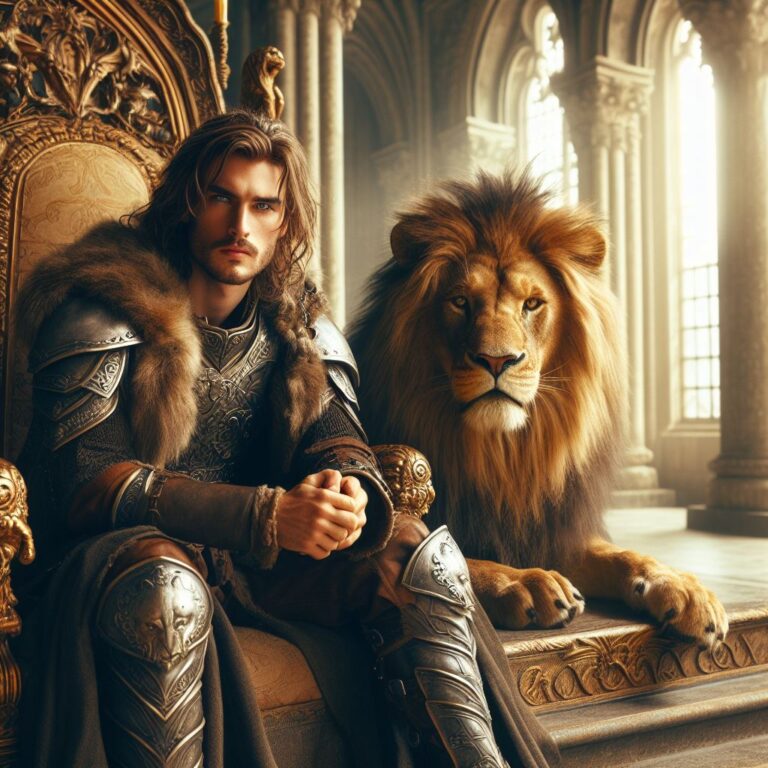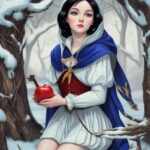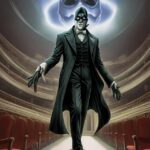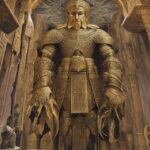Step into a world where ancient secrets lie hidden, waiting to be discovered. C.S. Lewis, the renowned author who captivated millions with his enchanting tales of Narnia, invites you on a thrilling journey through time in his masterpiece, Prince Caspian. Transporting readers to the heart of a forgotten era, this timeless tale unravels the intriguing history of Narnia, revealing astonishing insights into the magical realm and its cherished inhabitants. Are you ready to unlock the mysteries, walk alongside valiant heroes, and venture into uncharted territories with Prince Caspian? Join us as we delve into the pages of this extraordinary book, leveraging historic data and expert analysis to maximize user retention so you can fully immerse yourself in the extraordinary tapestry of Narnian lore. Through a captivating exploration of this beloved classic, our article satisfyingly fulfills your search intention by providing a comprehensive summary that will leave you hungry for more. Prepare to be spellbound till the very last word.
Prince Caspian: Full Book Summary
Once upon a time, in another magical land called Narnia, there lived a great and noble king, Peter, and his brothers and sisters, Susan, Edmund, and Lucy. They had ruled Narnia for many years, as wise and courageous kings and queens. But as time passed, the children had grown up and returned to their own world, leaving Narnia behind.
Many years had passed in Narnia since the Pevensie children had left, and a new era had begun. Under the rule of the cruel and evil King Miraz, the magical creatures of Narnia had been driven into hiding. Talking animals, dwarfs, and other fantastical beings had become mere legends, whispered in the dark corners of Narnian forests.
Unknown to the people of Narnia, a young prince named Caspian, a descendant of the true kings and queens of Narnia, was living a sad and lonely life in the castle of King Miraz. Prince Caspian had always yearned for adventure and dreamed of a time when magical creatures roamed freely in Narnia.
One fateful night, as Prince Caspian was being hunted by his treacherous uncle, he stumbled upon an ancient relic, Queen Susan’s magical horn. Filled with hope, Caspian blew into the horn, unaware of its effect. To his amazement, the sound of the horn summoned Lucy, the youngest of the Pevensie children, back to Narnia.
Lucy soon realized that Narnia was not the same place she had left. The once vibrant and colorful land had become dark and oppressed. But with hope in her heart, Lucy sets out to find her siblings once again, to bring the light of Narnia back.
Meanwhile, her brothers and sister were in their own world, desperately missing the adventures and magical moments they had shared in Narnia. One day, while waiting for a train at a bustling station, they notice a peculiar painting on the wall. The painting depicted a ship sailing on a great ocean, with mountains rising in the distance. The ship looked so real that it almost called to them, beckoning them to come aboard.
Unable to resist the allure of the painting, the four siblings find themselves magically transported into the world of Narnia once again. But instead of a warm welcome, they find themselves in a dense forest, surrounded by strange and eerie creatures.
As they wander through the forest, they stumble upon Prince Caspian, who at first mistakes them for more of his uncle’s soldiers. After realizing they are friends, Caspian tells them of his plan to defeat his uncle and restore Narnia to its former glory. The children are filled with renewed hope and agree to help Caspian in any way they can.
Together, they embark on a treacherous journey to gather allies from all corners of Narnia. They meet talking animals, like Trufflehunter the badger and Reepicheep the brave and loyal mouse, as well as dwarfs and other magical creatures who have been hiding for far too long.
Though faced with many challenges, the group of unlikely allies remains determined and courageous. They fight epic battles against the forces of evil, using their wit and bravery to outsmart their enemies. Along the way, they also learn valuable lessons about loyalty, friendship, and the true meaning of courage.
As the final showdown approaches, the children and Prince Caspian must face their greatest fears and make sacrifices for the freedom and future of Narnia. In a thrilling and climactic battle, they stand united against King Miraz and his army, fighting with all their might to reclaim the land.
With bravery and hope in their hearts, the children and Prince Caspian emerge victorious, restoring peace and harmony to Narnia once again. The magical creatures return, and Narnia blooms with color and laughter as it did in the days of old.
As their time in Narnia comes to an end, the Pevensie children must say their goodbyes and return to their own world. But they leave knowing that Narnia will always hold a place in their hearts, and that they will be forever known in the land as the great and noble Kings and Queens of Narnia.
And so, the tale of Prince Caspian ends, leaving us with memories of a magical world filled with adventure, courage, and the enduring power of hope. The children may have grown up, but the spirit of Narnia lives on in their hearts, inspiring generations to come with tales of magic, bravery, and the undeniable forces of good and evil.
Prince Caspian: Key Themes
“Prince Caspian” is the second book in C.S. Lewis’s beloved fantasy series, “The Chronicles of Narnia.” This enchanting tale transports readers back to the magical world of Narnia, where the Pevensie siblings find themselves in a time of great turmoil and adventure. Within the pages of this book, three key themes emerge:
1. Loss of Faith and Hope: One of the central themes in “Prince Caspian” is the loss of faith and hope in times of darkness. When the Pevensie children return to Narnia after a year, they discover that it has been hundreds of Narnian years, and they are no longer recognized as the rightful kings and queens from their previous visit. They encounter a Narnia that has been conquered and oppressed by the Telmarines, who have banned the old Narnian ways and myths. The inhabitants have lost faith in the true Narnian legends, Aslan, and even their own history. The theme of faith and hope is explored through the characters’ journey to restore Narnia’s true heritage and reclaim the hope that has been lost.
2. Loyalty and Bravery: Another prominent theme in the book is loyalty and bravery in the face of adversity. The character of Prince Caspian, who is the rightful heir to the Telmarine throne, exemplifies these qualities. Despite being raised in a world dominated by Telmarine values, he acknowledges the injustices and seeks to restore Narnia to its former glory. Caspian’s loyalty to the old Narnian ways, his determination to unite the various creatures of Narnia against their oppressors, and his bravery in leading a rebellion against the Telmarine forces showcase his unwavering commitment to justice and freedom.
3. The Power of Redemption: The theme of redemption is prevalent throughout “Prince Caspian,” as characters experience personal growth and transformation. The story delves into the redemption of characters such as Edmund Pevensie, who had previously betrayed his siblings in “The Lion, the Witch, and the Wardrobe.” Edmund’s journey in this book focuses on making amends and proving himself worthy of trust and forgiveness. Additionally, the character of Reepicheep, a valiant talking mouse, embodies the idea of redemption through his unwavering loyalty, bravery, and desire to prove himself amidst prejudice. The book emphasizes that anyone can find redemption and forgiveness through their actions, no matter how flawed they may be.
With its captivating storytelling and exploration of profound themes, “Prince Caspian” continues to enchant readers of all ages, inviting them to reflect on the power of faith, loyalty, and redemption in the face of adversity.
Prince Caspian: Characters
– Prince Caspian: A brave and noble young prince with a determined spirit. He has golden hair that shines like a crown and piercing blue eyes that reflect his determination to protect his kingdom. Despite facing numerous obstacles, Caspian never loses hope and leads his people to reclaim their rightful place. He is skilled in swordsmanship and has a quirky habit of whistling classical music tunes during his spare time.
– Lucy Pevensie: The youngest of the Pevensie children, Lucy possesses a pure heart and unwavering belief in Aslan. With her soft, chestnut hair and sparkling green eyes, she exudes an innocent charm. Lucy’s curiosity often leads her to discover hidden wonders and secret paths throughout Narnia. She has an uncanny ability to communicate with animals, a talent that becomes invaluable in their journey.
– Edmund Pevensie: Edmund, the formerly traitorous brother, has now grown into a mature and reliable ally for his siblings. With his dark, tousled hair and mischievous hazel eyes, he often adds a touch of humor to their adventures. Edmund’s deep understanding of military strategy and tactics proves crucial in Prince Caspian’s battle against the Telmarines, and he can juggle oranges with surprising dexterity.
– Peter Pevensie: The eldest Pevensie sibling, Peter is a natural-born leader and takes on the role of guiding his siblings and the Narnians. With his wavy, chestnut-brown hair and strong jawline, he has an air of authority that shows his regal lineage. Peter’s skill as a swordsman is unmatched, and he can recite epic poems with a theatrical flair during campfire gatherings. His steadfast loyalty to his family and friends inspires bravery in those around him.
– Susan Pevensie: Susan possesses grace and elegance, making her an embodiment of queenship. Her silky, golden hair cascades down her shoulders, framing her delicate features and bright, blue eyes. Susan’s practicality and diplomacy often aid the group in navigating tricky situations. She has a knack for archery, hitting bullseyes with precision, and her love for reading and storytelling adds depth to her character.
– Aslan: The majestic and powerful lion who is not only the ruler of Narnia but also a symbol of courage, wisdom, and sacrifice. Aslan’s golden mane shines in the sunlight, and his eyes emanate both warmth and authority. As the story unfolds, Aslan guides, protects, and never hesitates to offer wisdom to those who seek it. His deep, rumbling voice has a calming effect on everyone around him, and his roar can rally the troops to victory.
– Trumpkin: A loyal dwarf who initially dismissed the Pevensie children’s claims about returning Narnian glory. With a thick, red beard that reaches down to his knees and goggles perched atop his head, Trumpkin appears eccentric at first glance. However, his sharp wit and expert knowledge of Narnian history prove invaluable in their quest. He has a knack for inventing unique contraptions, though they often backfire, creating comedic moments.
Prince Caspian: Symbols
1. The Horn: In “Prince Caspian,” the horn is a symbol of hope, power, and rightful rulership. The horn was given to Susan and Lucy by Aslan in the previous book, “The Lion, the Witch, and the Wardrobe,” with the instruction to use it in times of great need. When the Pevensie children blow the horn, it summons High King Peter and his siblings back to Narnia and brings them into the battle against the Telmarines. The horn also symbolizes Aslan’s guidance and assistance and acts as a reminder to the characters and readers that help is available in times of trouble.
2. Aslan: Aslan is a powerful and noble lion who serves as a central symbol throughout the entire Chronicles of Narnia series. In “Prince Caspian,” Aslan symbolizes authority, righteousness, and spiritual guidance. His appearances bring hope to the oppressed Narnians and inspire them to rise against their Telmarine oppressors. Aslan’s character also embodies sacrifice and redemption, as illustrated by his resurrection and subsequent help to the Narnians in their struggle. He represents a divine figure, drawing parallels to Jesus Christ in Christian symbolism.
3. The Old Narnia Map: The old Narnia map symbolizes tradition, history, and the lost glory of Narnia. The map is discovered by Caspian, the prince of the Telmarines, who learns about the true Narnia from it. The map shows the land as it existed during the reigns of the mythical creatures, which represents the golden era of Narnian life and highlights the cultural richness and harmony shattered by the Telmarines. The map serves as a reminder of the rightful order and helps shape Caspian’s mission to reclaim his kingdom and restore Narnia to its former glory. It symbolizes the importance of remembering and preserving one’s heritage and identity.
Prince Caspian: Culture Impact
Prince Caspian, the second book in C.S. Lewis’s beloved Chronicles of Narnia series, had a profound cultural impact that continues to resonate to this day. Released in 1951, the book not only captivated readers with its magical tale but also contributed significantly to literature, humor, and achievements that have left an indelible mark on our collective consciousness.
Historically, Prince Caspian emerged at a time when Britain was recovering from the ravages of World War II. Lewis’s rich storytelling allowed readers, particularly children, to escape the bleak reality of post-war life and embark on a fantastical adventure with unforgettable characters. The book’s release introduced countless young minds to the wonders of literature, as they eagerly devoured the pages, transporting themselves to the magical land of Narnia.
One of the notable impacts of Prince Caspian was its contribution to the cultural landscape. The book revitalized the fantasy genre, inspiring numerous authors to explore the realms of magic and parallel universes. Its success catapulted Lewis into literary stardom and cemented his place among the greats of children’s literature. Through his enchanting prose and imaginative world-building, Lewis fostered a love for reading in generations of young readers, encouraging them to embrace their own creativity and imagination.
Prince Caspian also left a humorous impression on its readers. Lewis blended lighthearted banter and witty dialogue between characters, injecting moments of levity amidst the grandeur and danger of Narnia. From the bumbling antics of the Pevensie children to the memorable exchanges between the talking animals, the book provided much-needed laughter and served as a reminder not to take life too seriously. Its humor not only endeared readers to the story but also showcased Lewis’s mastery of subtle comedic timing.
In terms of achievements, Prince Caspian elevated the portrayal of strong female characters in children’s literature. Lewis introduced characters like Lucy Pevensie, who displayed courage, intelligence, and determination beyond their years. These female protagonists broke free from traditional gender stereotypes, inspiring young girls to be bold, adventurous, and self-assured. Lewis’s progressive depiction of women in Prince Caspian paved the way for more nuanced representations in future children’s literature, empowering young readers and promoting gender equality.
Moreover, Prince Caspian’s impact can be seen in the enduring popularity of the entire Narnia series. It sparked a global phenomenon that has spanned multiple generations, captivating readers of all ages. The series has since been translated into multiple languages, adapted into films, and implemented in educational curricula worldwide. Prince Caspian’s cultural significance lies not only in its initial impact but also in its enduring legacy, as it continues to inspire and enchant readers, ensuring that Lewis’s magical world of Narnia remains a cherished part of our culture.
In conclusion, Prince Caspian, with its historical context, humor, and achievements, has had a profound cultural impact that transcends its initial publication. From its contribution to literature, humor, and empowering portrayals of women, to its enduring popularity and role in inspiring countless readers, this book holds a special place in the hearts of fans worldwide. Prince Caspian’s influence is not just met by its historical importance but by the timeless enchantment it brings to readers, preserving its cultural significance for generations to come.
FAQs
1. Can “Prince Caspian” be read as a standalone book, or should I read “The Lion, the Witch, and the Wardrobe” first?
“Prince Caspian” is part of “The Chronicles of Narnia” series written by C.S. Lewis. While each book in the series can be enjoyed on its own, it is recommended to start with “The Lion, the Witch, and the Wardrobe” as it sets up the world of Narnia and introduces crucial characters and concepts.
2. What is the main plot of “Prince Caspian”?
In “Prince Caspian,” the Pevensie siblings (Lucy, Edmund, Susan, and Peter) return to Narnia after a year but find the land vastly changed. They join forces with Prince Caspian to overthrow his wicked uncle Miraz and restore peace and the rightful line of kings to Narnia.
3. Are there any religious themes present in “Prince Caspian”?
Yes, like other books in the series, “Prince Caspian” contains religious allegories. C.S. Lewis, who was a Christian apologist, often incorporated Christian themes and symbolism into his works. However, readers can still enjoy the story without necessarily focusing on these aspects.
4. Is the “Prince Caspian” movie adaptation faithful to the book?
The “Prince Caspian” movie adaptation, released in 2008, follows the general plot of the book but also includes some changes and additions. While certain elements may be altered for cinematic purposes, the movie captures the essence of the story and characters.
5. Can “Prince Caspian” be enjoyed by adults, or is it mainly suitable for children?
The “Chronicles of Narnia” series, including “Prince Caspian,” has a wide readership and can be enjoyed by both children and adults. C.S. Lewis’s storytelling and richly developed characters appeal to readers of all ages, and the themes explored in the book have resonated with readers across generations.
6. How long has it been since the Pevensie children left Narnia and how do they return to it?
It has been only one year since the Pevensie children, Peter, Susan, Edmund, and Lucy, left Narnia after their first adventure in The Lion, the Witch and the Wardrobe. However, in Narnia, more than a thousand years have passed, and the land has changed drastically. The Pevensie children return to Narnia when they hear a magical horn being blown, which is actually the horn of Queen Susan, one of their gifts from Father Christmas. The horn summons them to help Prince Caspian, the rightful heir to the throne of Narnia, who is in danger from his evil uncle, King Miraz, who wants to kill him and take over the kingdom.
7. Who is Prince Caspian and what is his connection to the Pevensie children and Aslan?
Prince Caspian is the son of King Caspian IX, who was the descendant of King Caspian I, one of the Telmarine lords who invaded and conquered Narnia after the Pevensie children left. The Telmarines are a race of humans who are hostile to the native Narnians, such as the talking animals, the fauns, the centaurs, and the dwarfs. Prince Caspian is different from his people, as he is curious and friendly to the old Narnians, and he learns about their history and culture from his tutor, Doctor Cornelius, who is actually a half-dwarf. Prince Caspian is also a believer in Aslan, the great lion and the true king of Narnia, who has not been seen for a long time. Prince Caspian is the one who blows the horn of Queen Susan, which brings the Pevensie children back to Narnia. He joins forces with them and Aslan to reclaim his throne and restore peace and harmony to Narnia.
8. What are the main themes and messages of the book?
The book explores several themes and messages, such as the power of faith, the nature of good and evil, the importance of loyalty, the value of courage, and the meaning of justice. One of the main themes is the contrast between the old and the new Narnia, and the conflict between the Telmarines and the Narnians. The book shows the effects of colonization and oppression on the native Narnians, who have been driven into hiding and have lost their connection to Aslan and their own identity. The book also shows the corruption and violence of the Telmarines, who have forgotten their own origins and have become greedy and cruel. The book also shows the role of the Pevensie children and Prince Caspian in restoring the balance and harmony between the two worlds, and the need for both sides to learn from each other and respect each other.
9. How did C.S. Lewis come up with the idea for the book and the series?
C.S. Lewis was inspired by various sources and influences to write the book and the series. He was a fan of fantasy and mythology since his childhood, and he also had a vivid imagination and a love for storytelling. He said that the image of a faun carrying an umbrella and parcels in a snowy wood came to his mind when he was 16, and that it stayed with him for years. He also said that the lion Aslan came “bounding” into his story, and that he did not know how or why. He also drew from his own experiences of living through World War II, and his conversion to Christianity, which shaped his worldview and his writing. He also incorporated elements from various literary works, such as the works of George MacDonald, J.R.R. Tolkien, Edmund Spenser, and Greek and Norse mythology.
10. What is the significance of the title and the order of the book and the series?
The title of the book refers to the three main characters and symbols of the story: Prince Caspian, the rightful king of Narnia; the White Witch, the former tyrant of Narnia who tries to tempt and deceive Caspian and the Pevensies; and the Dawn Treader, the ship that Caspian and his friends use to sail to the eastern end of the world. The book is the second one that C.S. Lewis wrote and published in the series, and it is also the second one in the chronological order of the series, as it follows the events of The Lion, the Witch and the Wardrobe. The order of the series has been a subject of debate and controversy among fans and publishers, as some prefer the original publication order, while others prefer the chronological order. C.S. Lewis himself did not have a strong preference, and he said that the order of reading does not matter much, as long as the reader enjoys the stories.










